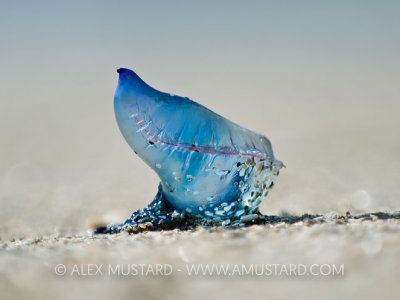
Domain: Eukarya
Kingdom: Animalia
Phylum: Cnidaria
Class: Hydrozoa
Order: Siphonophorae
Family: Physaliidae
Genus: Physalia
Species: Physalia physalis
It’s summer time, the time of year I get to listen to the “jellyfish invasion.” Now, don’t get me wrong; jellies are increasing in number, and there are concerns about their large populations. However, Portuguese man-o-wars are not jellyfish—they’re siphonophores!
Siphonophores are the misunderstood cousins to jellyfish, especially Physalia physalis. Jellyfish are typically a single individual with a polyp stage. Siphonophores are a colony of individual organisms called polyps, and each group of individuals does a specific job for the colony.
Portuguese man-o-wars are made up of four separate polyps: the sails, the tentacles, the digestive organs, and reproductive system. Imagine that you and three of your clones, called zooids, live in an RV together. You are in charge of driving the RV, one clone is in charge of gathering food to feed everyone, one is the cook, and the other is responsible for replacing damaged or missing zooids. Without one of your clones, everyone in the RV would die, and RV would eventually stop moving. Same can be said about siphonophores and P. physalis.
The pneumatophore is the gas-filled bladder at the top; it’s the purple-bluish structure you can see floating on top of the water. This zooid is responsible for the colony’s movement. However, the gas-filled bladder works more like a sail; the wind and surface currents do the actual moving of the colony. This is how they got their name, because the gas-filled bladder resembled the sails of man-o-wars, a type of naval ship.
The tentacles are another organism, or zooid, of P. physalis. On average, the tentacles can extend 30 feet below water, but a single colony was recorded with tentacles as long as 165 feet! The tentacles contain venom-filled nematocysts, which they use to paralyze and capture prey. Portuguese man-o-wars feed on fish, shrimp, and other small creatures.
Gastrozooids are the polys in charge of digesting the prey and distributing the nutrients to the other polyps in the colony. Essentially, they are the digestive system of the colony. Unlike the sail and the tentacles, they have no distinctive “structure” on the colony, so they can’t be identified in a photograph.
The last type of zooid is responsible for reproduction. These polyps create other polyps for each of the groups, replacing those that have died or have been damaged. They are also responsible for exchanging genetic material with other Portuguese man-o-wars.
Portuguese man-o-wars are found in tropical and subtropical waters, and they can be found floating in large numbers—even in the thousands. I know in the US every summer, media warns the East Coast about these siphonophores washing up on public beaches.
P. phyaslis can be harmful to humans. I’d hate to be out swimming and get stung by the long tentacles! While live man-o-wars can be harmful to swimmers, dead ones are also a concern. While the venom is rarely fatal, it hurts worse than an army of wasp stings, and the nematocysts can still sting humans after death. So if you seem a dead one wash up on the beach—DON’T TOUCH IT!
If you notice Portuguese man-o-wars in the water or washed up, notify the lifeguards and everyone around you immediately. If you’ve been stung, do not use urine or vinegar on the inflamed area.
Dive manuals suggest that you carefully remove any remaining tentacles and flush the area with sea water, never fresh water. As soon as possible, immerse the affected area in hot water of at least 112°F for twenty minutes. This will denature the toxin and break up the chemicals.
I have never seen a Portuguese man-o-war in person despite living on the eastern coast of the United States and frequenting beaches in the summer. However, I don’t think I’m terribly upset with the idea, because with my luck, I’d get stung! Siphonophores are pretty interesting, though, and I can’t wait to share more with you!
Links and sources:
Reef Creature Identification Florida Caribbean Bahamas 3rd edition by Paul Humann, Ned DeLoach, and Les Wilk ⇐had the info on how to treat the sting
https://www.nationalgeographic.com/animals/invertebrates/p/portuguese-man-of-war/ ⇐in-depth look into the sections of the man-o-wars
https://oceanservice.noaa.gov/facts/portuguese-man-o-war.html ⇐simplified info
https://www.britannica.com/animal/Portuguese-man-of-war


